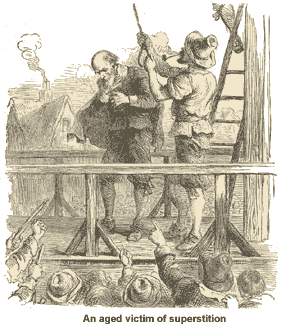In 1692, three pre-teen girls from prominent families in Salem Village (now Danvers, Massachusetts) accused a West Indian slave of being a witch. These allegations were not the first incidents of witch-baiting in New England; in previous years, several dozen persons were accused of Satanic practices and three were hanged.
The 17th century was still an age in which people at all educational levels believed that an individual could sell his soul to the Devil in return for vast powers of witchcraft. Among the believers were such notables as the Rev. Cotton Mather, Puritanism's leading light in America. A book he had written, which described the powers and behavior of witches, fell into the girls' hands and may have prompted them to act.
 The slave Tituba was flogged and she confessed to practicing witchcraft. Her trial touched off a fire storm of charges and countercharges; one neighbor used an allegation against another to settle a simmering feud. At the height of the hysteria, more than 150 people were accused. Plainly innocent people attempted to avoid the noose by confessing to such activities as having sexual relations with the Devil and flying on broomsticks.
Mather used his influence to mold the proceedings, at least in the early stages. The five-man court that heard the witchcraft charges contained three members of Mather’s congregation. The minister also wrote to the judges to urge them to admit spectral evidence, statements made by spirits to the victims of witchcraft.
In the summer of 1692, Mather traveled to Salem to witness the execution of George Burroughs, a former minister who had been found guilty of consorting with the Devil. To the amazement of all assembled, the convicted man stood on the scaffold and was able to recite the Lord’s Prayer without error — an act thought to be impossible for anyone who had sold his soul. Many in the crowd urged that the execution be stopped, but Mather intervened, reminding the witnesses that the accused had been duly convicted by a court. Burroughs was hanged in accordance with his sentence.
The tide turned against the frenzy only when prosperous and influential members of the community began to be the targets of accusations. They used their authority to call off the special court in the fall of 1692. By that time, 15 women and four men had been hanged. One man, Giles Corey, refused to enter a plea. He was bound and placed on the ground; heavy rocks were piled on his chest to induce him to speak. His only remark, it was reported, was to gasp, "More weight!" The authorities obliged and Corey was pressed to death.
Later historical studies of the Salem hysteria have revealed that those most often accused of witchcraft were women at the fringe of society — those who had few children and friends, those who had quarreled with their neighbors and those single women who had accumulated wealth or property. The events in Salem demonstrated how a volatile mixture of religion, fear and jealousy could erupt into frenzy. The Salem trials marked the last time a person was executed for witchcraft in America.
The slave Tituba was flogged and she confessed to practicing witchcraft. Her trial touched off a fire storm of charges and countercharges; one neighbor used an allegation against another to settle a simmering feud. At the height of the hysteria, more than 150 people were accused. Plainly innocent people attempted to avoid the noose by confessing to such activities as having sexual relations with the Devil and flying on broomsticks.
Mather used his influence to mold the proceedings, at least in the early stages. The five-man court that heard the witchcraft charges contained three members of Mather’s congregation. The minister also wrote to the judges to urge them to admit spectral evidence, statements made by spirits to the victims of witchcraft.
In the summer of 1692, Mather traveled to Salem to witness the execution of George Burroughs, a former minister who had been found guilty of consorting with the Devil. To the amazement of all assembled, the convicted man stood on the scaffold and was able to recite the Lord’s Prayer without error — an act thought to be impossible for anyone who had sold his soul. Many in the crowd urged that the execution be stopped, but Mather intervened, reminding the witnesses that the accused had been duly convicted by a court. Burroughs was hanged in accordance with his sentence.
The tide turned against the frenzy only when prosperous and influential members of the community began to be the targets of accusations. They used their authority to call off the special court in the fall of 1692. By that time, 15 women and four men had been hanged. One man, Giles Corey, refused to enter a plea. He was bound and placed on the ground; heavy rocks were piled on his chest to induce him to speak. His only remark, it was reported, was to gasp, "More weight!" The authorities obliged and Corey was pressed to death.
Later historical studies of the Salem hysteria have revealed that those most often accused of witchcraft were women at the fringe of society — those who had few children and friends, those who had quarreled with their neighbors and those single women who had accumulated wealth or property. The events in Salem demonstrated how a volatile mixture of religion, fear and jealousy could erupt into frenzy. The Salem trials marked the last time a person was executed for witchcraft in America.